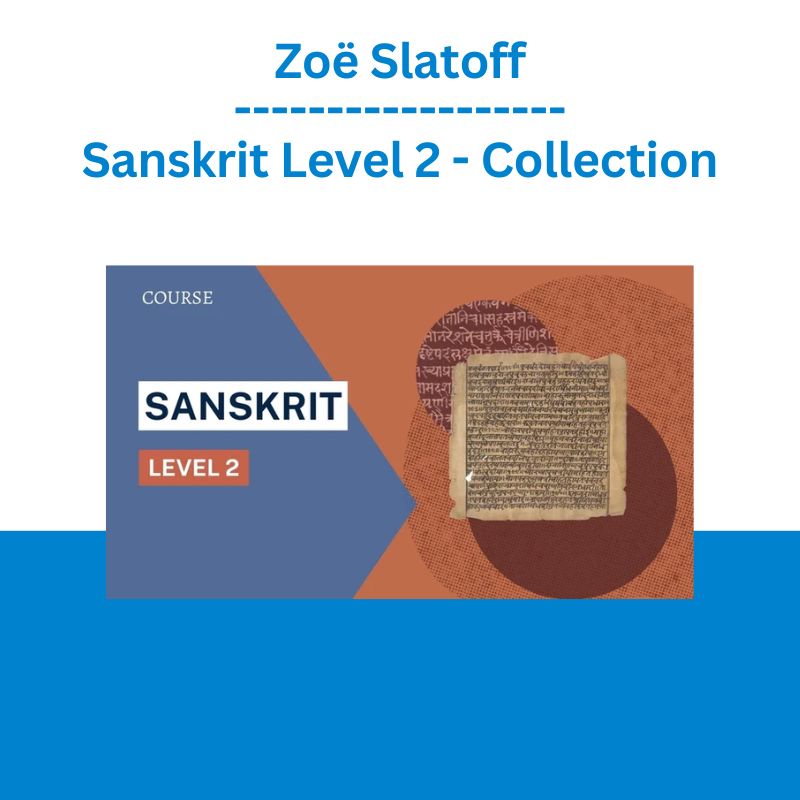*** Proof of Product ***
Exploring the Essential Features of “Zoë Slatoff – Sanskrit Level 2 – Collection”
About
In this course, students will build upon what we learned in the Introduction to Sanskrit course. We will begin by learning masculine and neuter nouns, ending in -a, together with their eight cases. We will go through specific examples of each case together, reading from texts such as the Bhagavad Gītā and Haṭha Pradīpikā. We will then learn ātmanepada present tense verbs and feminine nouns ending in ā, finishing with a review of sandhi, word combination. Students will study from Zoë’s book, “Yogāvatāraṇam: The Translation of Yoga,” which she wrote to join Eastern and Western methods and theory and practice together.
In each session, we will cover a few new concepts. Students will be given weekly homework assignments to do for the next class. Answers will be reviewed in the following class and posted on the Facebook forum. It is suggested that students continue to develop a Sanskrit study practice. Like with yoga, Sanskrit is best learned through consistent practice, rather than through quantity. It is recommended that students do 15-20 minutes a day rather than an hour a couple of times a week.
Module 1: Masculine and Neuter Nouns and the Nominative Case
In this module, we will start Chapter 3 of “Yogāvatāraṇam: The Translation of Yoga,” beginning with the eight declensions for masculine and neuter nouns ending in -a and learning some common nouns. We will then look at the nominative, or subject case, in detail, with examples.
Module 2: The Accusative and Instrumental Cases
We will begin by reviewing the declensions of masculine and neuter nouns and the examples of the nominative. We will then look at the accusative or object case and the instrumental case, which is used to show agency and explain how things are done, going through examples of each together.
Module 3: The Dative and Ablative Cases
We will start with a review of the verses focused on the accusative and instrumental cases. We will then look at the dative case, used for the indirect object or purpose, and the ablative case, used to express action from something or to express an origin or reason. We will also look at examples of both cases.
Module 4: The Genitive and Locative Cases
In this module, we will start by reviewing the verses on the genitive and locative cases. We will then learn the final case, the vocative, used to address a person, god, or personified object. We will then take some time to review the whole chapter.
Module 5: Vocative Case and Review
In this module, we will start by reviewing the verses on the genitive and locative cases. We will then learn the final case, the vocative, used to address a person, god, or personified object. We will then take some time to review the whole chapter.
Module 6: Present Tense Verbs, Ātmanepada Conjugations
We will start by going over the review exercises from Chapter 3. We will then begin Chapter 4 of Yogāvatāraṇam: The Translation of Yoga.” We will learn present tense verbs in the ātmanepada voice, originally considered self-reflexive verbs. We will go through the conjugations in detail and look at an example.
Module 7: Feminine Nouns Ending in -ā
After reviewing the exercises on the ātmanepada voice, we will learn the declensions for feminine nouns ending in -ā and -ī. We will learn some common nouns and then go through an example together.
Module 8: Sandhi Review
In this session, we will review the declensions of feminine nouns ending in -ā and ī and the verse examples. We will then do a review of the sandhi (word combination) rules we have learned in the previous chapters.
Module 9: Review
In our final session, we will go over the review exercises, including one on learning how to add sandhi rules yourself as well as doing translation. We will also take some time to review Chapters 3 and 4 and answer any remaining questions you may have.
Students who take this course will:
To read and write the devanāgarī script.
To read key yoga terms and understand their meaning.
To read verses and sūtras from classical yoga texts.
The structure of the most common type of verse.
To translate simple verse
Proper Sanskrit pronunciation.
Masculine, feminine, and neuter nouns
The eight cases of all nouns
To read verses and sūtras from classical yoga texts
To read more fluently, with a continued focus on proper pronunciation.
Sandhi rules for joining words together.
Author
Zoë Slatoff
Zoë Slatoff has a Master’s Degree in Asian Languages and Culture from Columbia University. She is the author of Yogāvatāraṇam: The Translation of Yoga, a Sanskrit textbook for yoga students, which uses extracts from classical yoga texts to integrate traditional and academic methods of learning the language. She is now working on a Ph.D. in South Asian Studies at Lancaster University, centering on a translation of the Aparokṣānubhūti, a text attributed to Ādi Śaṅkarācārya, which by integrating Yoga and Advaita Vedānta, teaches how _sana practice can actually help one transcend the attachment to bodily form and provide a vehicle for recognition of the Self. Zoë has been practicing and teaching yoga for over 20 years. She teaches daily Mysore classes at her yoga shala in New York, Ashtanga Yoga Upper West Side.
Please see the full list of alternative group-buy courses available here: https://lunacourse.com/shop/










 Racing Workshop - Complete Online Package
Racing Workshop - Complete Online Package  The Daily Traders – Exclusive Trading Mentorship Group
The Daily Traders – Exclusive Trading Mentorship Group  Roger Dooley - Building Habits and Loyalty
Roger Dooley - Building Habits and Loyalty  Ed Ponsi - Forex Trading
Ed Ponsi - Forex Trading  Roger Dooley - Building Trust
Roger Dooley - Building Trust  Simpler Trading - Bruce Marshall - The Options Defense Course
Simpler Trading - Bruce Marshall - The Options Defense Course  Dylan Forexia - Signature Trade from Forexia
Dylan Forexia - Signature Trade from Forexia  Roger Sanchez - Music Industry Hustle in a Digital Age
Roger Sanchez - Music Industry Hustle in a Digital Age  Roger Sanchez - How To Use Ableton & Logic To Make a Track
Roger Sanchez - How To Use Ableton & Logic To Make a Track  Roger Dooley - Nonconscious Motivation
Roger Dooley - Nonconscious Motivation  Akil Stokes & Jason Graystone - TierOneTrading - Trading Edge 2019
Akil Stokes & Jason Graystone - TierOneTrading - Trading Edge 2019  Money Miracle - George Angell - Use Other Peoples Money To Make You Rich
Money Miracle - George Angell - Use Other Peoples Money To Make You Rich